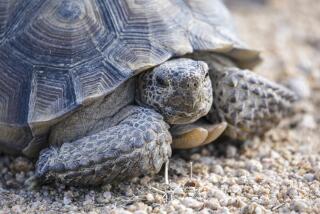Tortoises Get Chance to Win Life-or-Death Shell Game
- Share via
Unlike their heavily armored parents, baby desert tortoises are saddled with soft, fingernail-thin shells that make them “walking ravioli” for predators and reduce the chances that the imperiled species can be saved from extinction.
A key to improving the odds of survival for the tortoise may lie in the basement of a Cal State Dominguez Hills laboratory where biologists have established a special hatchery and nursery for the benign herbivores.
There, David Morafka, a professor of biology and an authority on the reptiles, and graduate student Michelle Joyner are pampering more than 60 “babies in the basement” with a goal of reviving and managing wild tortoise populations decimated by off-road vehicles, military maneuvers, housing developments, disease, poaching, drought and hungry ravens.
The tortoises under study in the laboratory were donated by collectors and breeders and eventually will be set free in the desert.
Once abundant in the deserts of California, Nevada, Utah and Arizona, there are only an estimated 60,000 desert tortoises left in the wilds, experts say.
The Cal State Dominguez Hills hatchery, which began operating earlier this month, is one of six being established at laboratories and protected lands throughout the Southwest in an effort to save the slow-moving tortoises, whose numbers have declined dramatically in the deserts around Southern California, Morafka said. The U.S. Fish and Wildlife Service plans to add the desert tortoise to the nation’s list of threatened species.
“We know very little about what goes on in the first year of a desert tortoise’s life,” Morafka said. “In fact, if we treated them as a separate species, they would be one of the least-understood animals in the desert.”
What little is known about infant tortoises, however, suggests that they are voracious, and ambitious, little critters.
“They eat like little wolves to grow like crazy and get out of the ‘ravioli’ stage as quickly as possible,” Morafka said. “They are also very ambitious--about two-thirds of them start digging burrows from day one.”
Even such impressive natural talents, however, are no match for developer’s bulldozers or for ravens, which regard baby tortoises as a favorite meal.
The tortoise hatchery at Cal State Dominguez Hills was funded entirely with a $27,000 grant from the Southern California Edison Co., which operates power lines and stations throughout the California desert.
“One of the problems we run into are land-use conflicts with critical species, and the desert tortoise is one of the most widely distributed endangered species in the desert,” said John Palmer, a research scientist with the utility. “The general commercial and residential growth in the region will increasingly impinge on tortoise habitat.”
A similar tortoise hatchery has been built outdoors with predator-proof brick and chicken wire in the Mojave Desert on land owned by the U.S. Army at Ft. Irwin, near Barstow.
“We’ve got about 60 eggs in two enclosures that should be hatching pretty soon,” said Tom Clark, a civilian ecologist at the Army base, otherwise reserved for desert training exercises. “The knowledge we gain here will be helpful to everybody, including the Army, because we need basic information to manage the impact of our maneuvers.”
Morafka suggested that saving tortoises has become a cause celebre, in part because they symbolize a “wholesome connection” with otherwise harsh and arid landscapes.
“When people think of the desert they think of tarantulas, rattlesnakes, scorpions and cactus,” Morafka said. “But the tortoise is a benign vegetarian, something that brings back good memories of growing up.”
More to Read
Sign up for Essential California
The most important California stories and recommendations in your inbox every morning.
You may occasionally receive promotional content from the Los Angeles Times.














